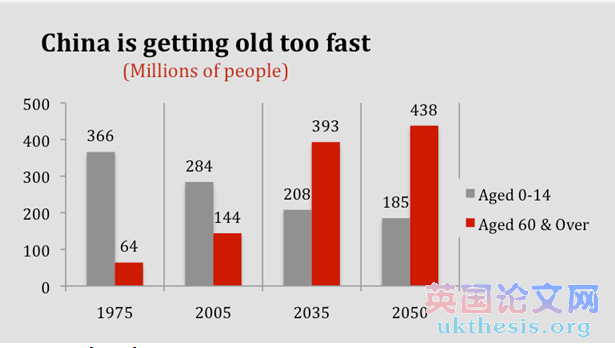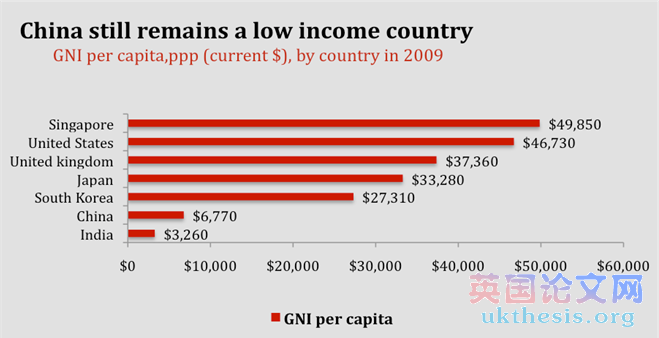英國紐卡斯爾大學(Newcastle University):中國老人退休現實和問題

Retirement reality and problems
退休現實和問題
2.1 Three elderly support approaches
三個養老方法
In China, people normally have three ways to provide old age. First is state pension income. Second is staying with family. Third is living by own savings.
在中國,人們通常有三種方式來提供老年。首先是國家的養老金收入。二是與家人住。三是自己的積蓄生活。
The present generation of people over age 60th are all born before 1949, the founding of People’s Republic of China. They are normally poor and still have the traditional concept of pension, and be together with their children is the best choice. Some of these elderly are receiving pensions from government at the same time. Thus the majority of present old generation is actually having a not bad old age. Elderly who choose the third type are generally not very old and also have good health condition. Once they get even older, they cannot live alone anymore. In other words, the effective pensions are only first two types.
現在這一代60歲以上的人都出生在1949年以前,中國人民共和國成立。他們通常是貧窮,還有傳統的養老觀念,與子女一起是最好的選擇。一些老人同時還從政府領取養老金。因此,目前老一代的大多數實際上是一個不壞的老年齡。誰選擇了第三種類型的老人一般不是很老,還具備良好的健康狀況。一旦他們變得更老了,他們不再獨自生活。換句話說,有效的養老金只有前兩種類型。
Elderly who living with their children could have a better care on both material and moral, but this status quo is not sustainable. There are two reasons.
與子女同住的老人在物質和精神上得到更好的照顧,但這種現狀是不可持續的。這里有兩個原因。
First is traditional concept change of old age life. On the one hand, majority of the present young people are willing not to live with their children after retirement. On the other hand, they also do not want to over-rely on their children financially due to the baptism in the modern values. These people will have more consideration on how to establish its own pension plan and increase savings. In another words, they will be more biased with the first or third way of pensions.
首先是老年生活的傳統觀念的變化。一方面,大部分當下年輕人愿意退休后不與子女同住。另一方面,他們也并不希望過度依賴財政對子女由于在現代價值觀的洗禮。這些人將有更多的考慮如何建立自己的退休金計劃及增加儲蓄。換句話說,他們會更偏向第一或第三條道路的養老金。
http://ukthesis.org/dissertation_sample
Second reason is much more important, which is aging population. Thirty-five years ago, the proportion of children population and elderly population was 6:1. However, after thirty-five years, this proportion will be inverted (Richard, 2004). The harsh winter of aging population is coming, and lead to the future of family structure will be like an inverted pyramid. When elderly people more than children, the informal family support network will be impossible to constantly maintain. Therefore, picture of the future left us only one choice, which is state pension insurance.#p#分頁標題#e#
第二個原因是更重要的,這是人口老齡化。三十五年以前,兒童人口與老年人口的比例為6:1。然而,后35年,這一比例將倒置(理查德,2004年)。人口老齡化的嚴酷的冬天就要來了,導致家庭結構的未來會像一個倒置的金字塔。當老人兒童多,非正式的家庭支持網絡將不可能始終保持。因此,未來之窗留給我們的只有一個選擇,這是國家養老保險。
2.2 Aging population, low average income and poor pension coverage
人口老齡化、低平均收入和貧乏的領取養恤金
Aging population is a global issue, but more serious in China.
人口老齡化是一個全球性的問題,但在中國更為嚴重。
Figure 2 – Demographic forecasting
圖2 - 人口預測

Source: UN (2007)
China gets old in one generation, while European countries used almost one hundred years. China’s labour force population will be reduced by 18%-35% around 2050. The “one-child” policy has controlled the population growth speed, but also controlled the birth rate. Plus longevity factor, China will become a white-haired country in 35 years. Most aging countries in the world were getting rich before getting old. If China cannot develop quicker than aging, after 35 years, China will face a very harsh situation, even a big social unrest.
中國一代人變老,歐洲國家將近用了一百年。中國的勞動力人口將減少18%-35%,到2050年左右。 “一胎化”政策,控制人口增長速度,但也控制人口出生率。加上長壽的因素,35年中國將成為一個白發蒼蒼的國家。在世界上多數老齡化國家致富變老之前。如果中國不能比老齡更快的發展,35年后,中國將面臨一個非常嚴峻形勢,即使是大的社會動蕩。
During the 30 years after Economic Opening, the average Gross Domestic Product (GDP) growth rate was 9.8 per cent in China, and 10.6 per cent in the past 5 years. Despite this long-term rapid economic growth, but up to now, it still cannot make up the negative effects of demographic explosion. In 2009, the Gross National Income (GNI) per capita in China was 6,770 dollars, while UK had 37,360 dollars and Singapore had 49,850 dollars. It was 7 times distance, which represent China is still a low-income country.
Figure 3 – Gross national income per capita in different countries
圖3 - 在不同的國家,人均國民總收入

Source: World Bank (2010)
Until 2010, China’s Gini index has exceeded 0.5, which means a big gap between rich and poor. In other words, the existing GNI per capita is pulled in some by rich people, and majority of average Chinese should have lower income. However, the present state pension system has not yet considered about wealth gap. It is really not good for social harmony.#p#分頁標題#e#
直到2010年,中國的基尼系數已經超過了0.5,這意味著一個大的富國和窮國之間的差距。換句話說,現有的人均國民總收入被拉在一些有錢的人,和大多數普通中國人應該有較低的收入。然而,目前國家養老金制度尚未考慮對貧富差距。這實在是不利于社會和諧。
Since the economic reform from 80years, China has started a rapid urbanization construction. Large number of labour force into the first-tier cities, but construction of rural areas did not keep up with the same period, resulting in a huge income page between urban and rural areas. And because most of young labour force into urban from rural areas, the aging population is more serious in rural areas.
從80年的經濟改革以來,中國已經開始了快速的城市化建設。與同期勞動力數量大到一線城市,但農村建設沒有跟上,導致在城市和農村地區之間巨大的收入頁面。而且,由于大多數青壯年勞動力從農村進入城市,人口老齡化是在農村地區更為嚴重。
Figure 4: Large number of uncovered
圖4: 大量揭露

Source: China Statistical Yearbook 2010
The income difference between urban and rural also results in two lines of China’s pension system. By 2008, pension coverage in urban was 72 per cent, while only 12 per cent in rural areas. However urban labour force accounted for only 39 per cent of national labour force, and rural labour force accounted for 61 per cent. That is the whole pension coverage rate is only 35.5 per cent in China. There were 499 million working people who still do not have pension insurance at all.
城市和農村之間的收入差異也導致兩行中國的養老保險制度。到2008年,在城市的養老保險覆蓋率為72%,而只有12%在農村地區。然而,城市的勞動力占全國勞動力的39%,占農村勞動力的61%。這是整個養老金的覆蓋率在中國只有35.5%。有4.99億人還沒有養老保險。
